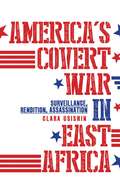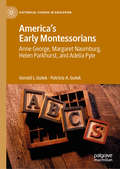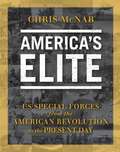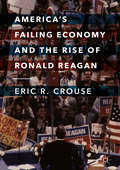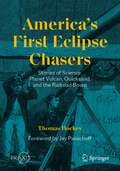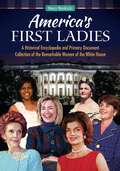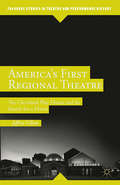- Table View
- List View
America's Cold War: The Politics of Insecurity, Second Edition
by Campbell Craig Fredrik Logevall“A creative, carefully researched, and incisive analysis of U.S. strategy during the long struggle against the Soviet Union.” —Stephen M. Walt, Foreign Policy “Craig and Logevall remind us that American foreign policy is decided as much by domestic pressures as external threats. America's Cold War is history at its provocative best.” —Mark Atwood Lawrence, author of The Vietnam War The Cold War dominated world affairs during the half century following World War II. America prevailed, but only after fifty years of grim international struggle, costly wars in Korea and Vietnam, trillions of dollars in military spending, and decades of nuclear showdowns. Was all of that necessary? In this new edition of their landmark history, Campbell Craig and Fredrik Logevall include recent scholarship on the Cold War, the Reagan and Bush administrations, and the collapse of the Soviet regime and expand their discussion of the nuclear revolution and origins of the Vietnam War to advance their original argument: that America’s response to a very real Soviet threat gave rise to a military and political system in Washington that is addicted to insecurity and the endless pursuit of enemies to destroy. America’s Cold War speaks vividly to debates about forever wars and threat inflation at the center of American politics today.
America’s Cold War against China: Destined to Fail (Routledge Studies on the Chinese Economy)
by Peter NolanThis book discusses how the USA has launched a new cold war against China.Showing how this New Cold War can only be fully understood by analysing the long-run history of the East and the West, and the fundamental differences between the Old and the New Cold Wars, this book outlines how the New Cold War focuses on issues connected with China’s territorial integrity: Xinjiang, the South China Sea, Hong Kong, Taiwan, and the closely connected conflict over semiconductors. It analyses the way in which China has responded to US-led Western aggression by following the approach suggested by Confucius: instead of ‘returning aggression with kindness’ or ‘returning aggression with aggression’, China has ‘returned aggression with firmness’. The book argues that the United States’ effort to establish hegemony over Eurasia has failed and that, in the face of this reality, there is no choice for the USA other than to cooperate with China in order to resolve the existential issues facing the human species.Demonstrating how US-led aggression has been rendered ineffective, this book will be a valuable resource to students and scholars of international relations and politics, including those in both China and the USA.
America’s Cold War against China: Destined to Fail (Routledge Studies on the Chinese Economy)
by Peter NolanThis book discusses how the USA has launched a new cold war against China.Showing how this New Cold War can only be fully understood by analysing the long-run history of the East and the West, and the fundamental differences between the Old and the New Cold Wars, this book outlines how the New Cold War focuses on issues connected with China’s territorial integrity: Xinjiang, the South China Sea, Hong Kong, Taiwan, and the closely connected conflict over semiconductors. It analyses the way in which China has responded to US-led Western aggression by following the approach suggested by Confucius: instead of ‘returning aggression with kindness’ or ‘returning aggression with aggression’, China has ‘returned aggression with firmness’. The book argues that the United States’ effort to establish hegemony over Eurasia has failed and that, in the face of this reality, there is no choice for the USA other than to cooperate with China in order to resolve the existential issues facing the human species.Demonstrating how US-led aggression has been rendered ineffective, this book will be a valuable resource to students and scholars of international relations and politics, including those in both China and the USA.
America's Cold Warrior: Paul Nitze and National Security from Roosevelt to Reagan
by James Graham WilsonIn America's Cold Warrior, James Graham Wilson traces Paul Nitze's career path in national security after World War II, a time when many of his mentors and peers returned to civilian life. Serving in eight presidential administrations, Nitze commanded White House attention even when he was out of government, especially with his withering criticism of Jimmy Carter during Carter's presidency. While Nitze is perhaps best known for leading the formulation of NSC-68, which Harry Truman signed in 1950, Wilson contends that Nitze's most significant contribution to American peace and security came in the painstaking work done in the 1980s to negotiate successful treaties with the Soviets to reduce nuclear weapons while simultaneously deflecting skeptics surrounding Ronald Reagan. America's Cold Warrior connects Nitze's career and concerns about strategic vulnerability to the post-9/11 era and the challenges of the 2020s, where the United States finds itself locked in geopolitical competition with the People's Republic of China and Russia.
America's Corporate Art: The Studio Authorship of Hollywood Motion Pictures (Post*45 #21)
by Jerome ChristensenContrary to theories of single person authorship, America's Corporate Art argues that the corporate studio is the author of Hollywood motion pictures, both during the classical era of the studio system and beyond, when studios became players in global dramas staged by massive entertainment conglomerates. Hollywood movies are examples of a commodity that, until the digital age, was rare: a self-advertising artifact that markets the studio's brand in the very act of consumption. The book covers the history of corporate authorship through the antithetical visions of two of the most dominant Hollywood studios, Warner Bros. and MGM. During the classical era, these studios promoted their brands as competing social visions in strategically significant pictures such as MGM's Singin' in the Rain and Warner's The Fountainhead. Christensen follows the studios' divergent fates as MGM declined into a valuable and portable logo, while Warner Bros. employed Batman, JFK, and You've Got Mail to seal deals that made it the biggest entertainment corporation in the world. The book concludes with an analysis of the Disney-Pixar merger and the first two Toy Story movies in light of the recent judicial extension of constitutional rights of the corporate person.
America's Covert War in East Africa: Surveillance, Rendition, Assassination (PDF)
by Clara UsiskinClara Usiskin has spent eight years investigating the 'War on Terror' and its effects in the East and Horn of Africa, documenting hundreds of cases of rendition, secret detention and targeted killings. As a result of her work exposing abuses carried out by regional governments and their international partners, Clara was deported from Kenya and Uganda and is currently persona non grata in both countries. Her book sets out the historical background to today's covert war, including the early Somali jihads and British repression in colonial Kenya, through to the 1998 US Embassy Bombings in Nairobi and Dar es Salaam, and President Clinton's early rendition programme. America's Covert War in East Africa then looks at the US Military's new Africa Command, with its emphasis on counterterrorism, alongside increasing use of targeted killings by security forces in the region, and continued renditions and secret detention. Finally, Usiskin investigates the shorter and longer term consequences of such intensive militarisation, and the proliferation of surveillance and other technologies of control in East Africa and its surrounding waters, focusing in particular on their impact on vulnerable ethnic and religious groups in a highly volatile region.
America’s Dream Palace: Middle East Expertise And The Rise Of The National Security State
by Osamah F. KhalilAs the postwar U.S. national security establishment required Middle Eastern expertise, it cultivated a beneficial relationship with universities. But by the time the Bush administration declared its Global War on Terror, Osamah Khalil shows, think tank agendas aligned with neoconservative goals were the drivers of America’s foreign policy.
America's Early Montessorians: Anne George, Margaret Naumburg, Helen Parkhurst and Adelia Pyle (Historical Studies in Education)
by Gerald L. Gutek Patricia A. GutekThis book traces the early history of the Montessori movement in the United States through the lives and careers of four key American women: Anne George, Margaret Naumburg, Helen Parkhurst, and Adelia Pyle. Caught up in the Montessori craze sweeping the United States in the Progressive era, each played a significant role in the initial transference of Montessori education to America and its implementation from 1910 to 1920. Despite the continuing international recognition of Maria Montessori and the presence of Montessori schools world-wide, Montessori receives only cursory mention in the history of education, especially by recognized historians in the field and in courses in professional education and teacher preparation. The authors, in seeking to fill this historical void, integrate institutional history with analysis of the interplay and tensions between these four women to tell this educational story in an interesting—and often dramatic—way.
America’s Elite: US Special Forces from the American Revolution to the Present Day (General Military Ser.)
by Chris McNabAmerica's Elites takes the reader through some of the most dramatic special forces operations in US history, from sniping British commanders during the Revolutionary War to Riverine incursions in the Mekong Delta in Vietnam, and from demolition missions on D-Day to the SEAL assault on Osama bin Laden's compound in 2011. Training and selection procedures are explained in detail, and the book also describes some of the technologies that have separated regular soldiers from their Special Forces counterparts. Illustrated throughout with striking photography and artworks, America's Elites forms the most comprehensive and visually impressive single-volume guide to US Special Forces available.
America’s Elite: US Special Forces from the American Revolution to the Present Day
by Chris McNabAmerica's Elites takes the reader through some of the most dramatic special forces operations in US history, from sniping British commanders during the Revolutionary War to Riverine incursions in the Mekong Delta in Vietnam, and from demolition missions on D-Day to the SEAL assault on Osama bin Laden's compound in 2011. Training and selection procedures are explained in detail, and the book also describes some of the technologies that have separated regular soldiers from their Special Forces counterparts. Illustrated throughout with striking photography and artworks, America's Elites forms the most comprehensive and visually impressive single-volume guide to US Special Forces available.
America's Failing Economy and the Rise of Ronald Reagan
by Eric R. CrouseThis book examines one of the most important economic outcomes in American history—the breakdown of the Keynesian Revolution. Drawing on economic literature, the memoirs of economists and politicians, and the popular press, Eric Crouse examines how economic decline in the 1970s precipitated a political revolution. Keynesian thought flourished through the presidencies of Lyndon B. Johnson, Richard Nixon, and Gerald Ford, until stagflation devastated American workers and Jimmy Carter’s economic policies faltered, setting the stage for the 1980 presidential campaign. Tracking years of shifting public opinion and colorful debate between free-market and Keynesian economists, this book illuminates a neglected era of American economic history and shows how Ronald Reagan harnessed a vision of small government and personal freedom that transformed the American political landscape.
America's Failing Economy and the Rise of Ronald Reagan
by Eric R. CrouseThis book examines one of the most important economic outcomes in American history—the breakdown of the Keynesian Revolution. Drawing on economic literature, the memoirs of economists and politicians, and the popular press, Eric Crouse examines how economic decline in the 1970s precipitated a political revolution. Keynesian thought flourished through the presidencies of Lyndon B. Johnson, Richard Nixon, and Gerald Ford, until stagflation devastated American workers and Jimmy Carter’s economic policies faltered, setting the stage for the 1980 presidential campaign. Tracking years of shifting public opinion and colorful debate between free-market and Keynesian economists, this book illuminates a neglected era of American economic history and shows how Ronald Reagan harnessed a vision of small government and personal freedom that transformed the American political landscape.
America's Failing Empire: U.S. Foreign Relations Since the Cold War (America's Recent Past #5)
by Warren I. CohenThis sharp and authoritative account of American foreign relations analyzes the last fifteen years of foreign policy in relation to the last forty years, since the end of the Cold War. Provides an overview and understanding of the recent history of U.S. foreign relations from the viewpoint of one of the most respected authorities in the field Includes suggestions for further reading.
America's Few: Marine Aces of the South Pacific
by Bill YenneAmerica's Few delves into the history of US Marine Corps aviation in World War II, following the feats of the Corps' top-scoring aces in the skies over Guadalcanal. Marine Corps aviation began in 1915, functioning as a self-contained expeditionary force. During the interwar period, the support of USMC amphibious operations became a key element of Marine aviation doctrine, and the small force gradually grew. But in December 1941 came the rude awakening. Within hours of Pearl Harbor, heroic Marine aviators were battling the Japanese over Wake Island. In the South Pacific, the aviators of the US Marine Corps came out of the shadows to establish themselves as an air force second to none. In the summer of 1942, when Allied airpower was cobbled together into a single unified entity – nicknamed 'the Cactus Air Force' – Marine Aviation dominated, and a Marine, Major General Roy Geiger, was its commander. Of the twelve Allied fighter squadrons that were part of the Cactus Air Force, eight were USMC squadrons. It was over Guadalcanal that Joe Foss emerged as a symbol of Marine aviation. As commander of VMF-121, he organized a group of fighter pilots that downed 72 enemy aircraft; Foss himself reached a score of 26. Pappy Boyington, meanwhile, had become a Marine aviator in 1935. Best known as the commander of VMF-214, he came into his own in late 1943 and eventually matched Foss's aerial victory score. Through the parallel stories of these two top-scoring fighter aces, as well as many other Marine aces, such as Ken Walsh (21 victories), Don Aldrich (20), John L. Smith (19), Wilbur Thomas (18.5), and Marion Carl (18.5), many of whom received the Medal of Honor, acclaimed aviation historian Bill Yenne examines the development of US Marine Corps aviation in the South Pacific.
America's Few: Marine Aces of the South Pacific
by Bill YenneAmerica's Few delves into the history of US Marine Corps aviation in World War II, following the feats of the Corps' top-scoring aces in the skies over Guadalcanal. Marine Corps aviation began in 1915, functioning as a self-contained expeditionary force. During the interwar period, the support of USMC amphibious operations became a key element of Marine aviation doctrine, and the small force gradually grew. But in December 1941 came the rude awakening. Within hours of Pearl Harbor, heroic Marine aviators were battling the Japanese over Wake Island. In the South Pacific, the aviators of the US Marine Corps came out of the shadows to establish themselves as an air force second to none. In the summer of 1942, when Allied airpower was cobbled together into a single unified entity – nicknamed 'the Cactus Air Force' – Marine Aviation dominated, and a Marine, Major General Roy Geiger, was its commander. Of the twelve Allied fighter squadrons that were part of the Cactus Air Force, eight were USMC squadrons. It was over Guadalcanal that Joe Foss emerged as a symbol of Marine aviation. As commander of VMF-121, he organized a group of fighter pilots that downed 72 enemy aircraft; Foss himself reached a score of 26. Pappy Boyington, meanwhile, had become a Marine aviator in 1935. Best known as the commander of VMF-214, he came into his own in late 1943 and eventually matched Foss's aerial victory score. Through the parallel stories of these two top-scoring fighter aces, as well as many other Marine aces, such as Ken Walsh (21 victories), Don Aldrich (20), John L. Smith (19), Wilbur Thomas (18.5), and Marion Carl (18.5), many of whom received the Medal of Honor, acclaimed aviation historian Bill Yenne examines the development of US Marine Corps aviation in the South Pacific.
America's Film Legacy: The Authoritative Guide to the Landmark Movies in the National Film Registry
by Daniel EaganAmerica's Film Legacy is a guide to the most significant films ever made in the United States. Unlike opinionated "Top 100" and arbitrary "Best of" lists, these are the real thing: groundbreaking films that make up the backbone of American cinema. Some are well-known, such as Citizen Kane, The Jazz Singer, All Quiet on the Western Front, The Birth of a Nation, and Boyz n the Hood. Others are more obscure, such as Blacksmith Scene, The Blue Bird, The Docks of New York, Star Theatre, and A Bronx Morning. Daniel Eagan's beautifully written and authoritative book is for anyone who loves American movies and who wants to learn more about them.
America's Film Legacy: The Authoritative Guide to the Landmark Movies in the National Film Registry
by Daniel EaganAmerica's Film Legacy is a guide to the most significant films ever made in the United States. Unlike opinionated "Top 100" and arbitrary "Best of" lists, these are the real thing: groundbreaking films that make up the backbone of American cinema. Some are well-known, such as Citizen Kane, The Jazz Singer, All Quiet on the Western Front, The Birth of a Nation, and Boyz n the Hood. Others are more obscure, such as Blacksmith Scene, The Blue Bird, The Docks of New York, Star Theatre, and A Bronx Morning. Daniel Eagan's beautifully written and authoritative book is for anyone who loves American movies and who wants to learn more about them.
America's Film Legacy, 2009-2010: A Viewer's Guide to the 50 Landmark Movies Added To The National Film Registry in 2009-10
by Daniel EaganAmerica's Film Legacy, 2009-2010Â is a guide to the most significant films ever made in the United States. Unlike opinionated "Top 100" and arbitrary "Best of" lists, these are the real thing: groundbreaking films that make up the backbone of American cinema. Each of the 50 newest titles in the National Film Registry is covered in a detailed essay that includes cast, credits, and major awards, as well as screening information and film stills. From well-known movies like The Muppet Movie and Dog Day Afternoon, to more obscure films, like A Study in Reds and Hot Dogs for Gauguin, Daniel Eagan's beautifully written and updated edition is for anyone who loves American movies and who wants to learn more about them.
America's Film Legacy, 2009-2010: A Viewer's Guide to the 50 Landmark Movies Added To The National Film Registry in 2009-10
by Daniel EaganAmerica's Film Legacy, 2009-2010 is a guide to the most significant films ever made in the United States. Unlike opinionated "Top 100" and arbitrary "Best of" lists, these are the real thing: groundbreaking films that make up the backbone of American cinema. Each of the 50 newest titles in the National Film Registry is covered in a detailed essay that includes cast, credits, and major awards, as well as screening information and film stills. From well-known movies like The Muppet Movie and Dog Day Afternoon, to more obscure films, like A Study in Reds and Hot Dogs for Gauguin, Daniel Eagan's beautifully written and updated edition is for anyone who loves American movies and who wants to learn more about them.
America’s First Eclipse Chasers: Stories of Science, Planet Vulcan, Quicksand, and the Railroad Boom (Springer Praxis Books)
by Thomas HockeyIn 2017, over 200 million Americans witnessed the spectacular total eclipse of the Sun, and the 2024 eclipse is expected to draw even larger crowds. In anticipation of this upcoming event, this book takes us back in history over 150 years, telling the story of the nation’s first ever eclipse chasers.Our tale follows the chaotic journeys of scientists and amateur astronomers as they trekked across the western United States to view the rare phenomenon of a total solar eclipse. The fascinating story centers on the expeditions of the 1869 total eclipse, which took place during the turbulent age of the chimerical Planet Vulcan and Civil War Reconstruction. The protagonists—a motley crew featuring astronomical giants like Simon Newcomb and pioneering female astronomers like Maria Mitchell—were met with unanticipated dangers, mission-threatening accidents, and eccentric characters only the West could produce. Theirs is a story of astronomical proportions. Along the way, we will make several stops across the booming US railroad network, traveling from viewing sites as familiar as Des Moines, Iowa, to ones as distant and strange as newly acquired Alaska.From equipment failures and botched preparations to quicksand and apocalyptic ‘comets’, welcome to the wild, western world of solar eclipses.
America's First Great Depression: Economic Crisis and Political Disorder after the Panic of 1837
by Alasdair RobertsFor a while, it seemed impossible to lose money on real estate. But then the bubble burst. The financial sector was paralyzed and the economy contracted. State and federal governments struggled to pay their domestic and foreign creditors. Washington was incapable of decisive action. The country seethed with political and social unrest. In America's First Great Depression, Alasdair Roberts describes how the United States dealt with the economic and political crisis that followed the Panic of 1837.As Roberts shows, the two decades that preceded the Panic had marked a democratic surge in the United States. However, the nation’s commitment to democracy was tested severely during this crisis. Foreign lenders questioned whether American politicians could make the unpopular decisions needed on spending and taxing. State and local officials struggled to put down riots and rebellion. A few wondered whether this was the end of America’s democratic experiment.Roberts explains how the country’s woes were complicated by its dependence on foreign trade and investment, particularly with Britain. Aware of the contemporary relevance of this story, Roberts examines how the country responded to the political and cultural aftershocks of 1837, transforming its political institutions to strike a new balance between liberty and social order, and uneasily coming to terms with its place in the global economy.
America's First Ladies: A Historical Encyclopedia and Primary Document Collection of the Remarkable Women of the White House
by Nancy HendricksMeet the First Ladies of the United States—sometimes inspiring, sometimes tragic, always fascinating—women who, though often unsung, helped hold the nation together in its infancy and advance it as a world power.More than simply serving as America's "hostesses," many of the nation's First Ladies played vital roles in shaping their husband's presidency and serving as political activists in their own right. From Martha Washington to Michelle Obama, their inspiring stories come alive in this handsomely illustrated encyclopedia. Within its pages, the First Ladies are revealed as human beings who, one day, awoke to find the eyes of the world upon them.The book differs from others by showcasing America's First Ladies in their own words, as flesh-and-blood individuals. Readers will discover which First Lady held off Napoleon's army with a toy sword, why women had to be "pale, frail, and ailing," and which First Lady was called "Sunshine" and which was "Hellcat." Each entry includes a biographical essay that details the life of the woman and places her within the political, social, and cultural context of her time. Each also offers a related primary document that helps define the First Lady's legacy as well as a short bibliography for further information. Written in a lively, compelling style, this highly readable volume is perfect for junior high, high school, and college students as well as the general public.
America's First Ladies: A Historical Encyclopedia and Primary Document Collection of the Remarkable Women of the White House
by Nancy HendricksMeet the First Ladies of the United States—sometimes inspiring, sometimes tragic, always fascinating—women who, though often unsung, helped hold the nation together in its infancy and advance it as a world power.More than simply serving as America's "hostesses," many of the nation's First Ladies played vital roles in shaping their husband's presidency and serving as political activists in their own right. From Martha Washington to Michelle Obama, their inspiring stories come alive in this handsomely illustrated encyclopedia. Within its pages, the First Ladies are revealed as human beings who, one day, awoke to find the eyes of the world upon them.The book differs from others by showcasing America's First Ladies in their own words, as flesh-and-blood individuals. Readers will discover which First Lady held off Napoleon's army with a toy sword, why women had to be "pale, frail, and ailing," and which First Lady was called "Sunshine" and which was "Hellcat." Each entry includes a biographical essay that details the life of the woman and places her within the political, social, and cultural context of her time. Each also offers a related primary document that helps define the First Lady's legacy as well as a short bibliography for further information. Written in a lively, compelling style, this highly readable volume is perfect for junior high, high school, and college students as well as the general public.
America’s First Regional Theatre: The Cleveland Play House and Its Search for a Home (Palgrave Studies in Theatre and Performance History)
by J. UllomThe Cleveland Play House has mirrored the achievements and struggles of both the city of Cleveland and the American theatre over the past one hundred years. This book challenges the established history (often put forward by the theatre itself) and long-held assumptions concerning the creation of the institution and its legacy.
The Americas' First Theologies: Early Sources of Post-Contact Indigenous Religion (AAR Religion in Translation)
by Garry SparksThe Theologia Indorum by Dominican friar Domingo de Vico was the first Christian theology written in the Americas. Made available in English translation for the first time, Americas' First Theologies presents a selection of exemplary sections from the Theologia Indorum that illustrate Friar Vico's doctrine of god, cosmogony, moral anthropology, understanding of natural law and biblical history, and constructive engagement with pre-Hispanic Maya religion. Rather than merely condemn the Maya religion, Vico appropriated local terms and images from Maya mythology and rituals that he thought could convey Christianity. His attempt at translating, if not reconfiguring, Christianity for a Maya readership required his mastery of not only numerous Mayan languages but also the highly poetic ceremonial rhetoric of many indigenous Mesoamerican peoples. This book also includes translations of two other pastoral texts (parts of a songbook and a catechism) and eight early documents by K'iche' and Kaqchikel Maya authors who engaged the Theologia Indorum. These texts, written in Highland Mayan languages both by fellow Dominicans and by Highland Maya elites demonstrate the wider influence of Vico's ethnographic approach shared by a particular school of Dominicans. Altogether, The Americas' First Theologies provides a rich documentary case example of the translation, reception, and reaction to Christian thought in the indigenous Americas




